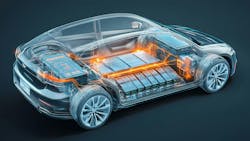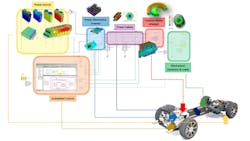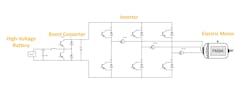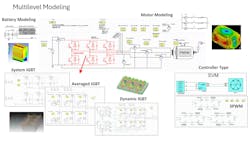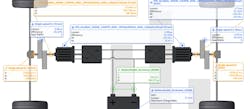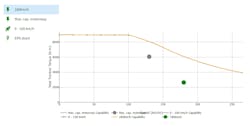Enhance EV Powertrain Performance with System-Level Simulation Modeling
What you’ll learn:
- How in-house-developed and third-party general-purpose simulation tools are limited to a few expert users and aren’t easily shareable.
- How multiphysics simulation of subsystems can result in an optimal powertrain design.
- How the modeling and simulation of an EV powertrain can be achieved quickly with a dedicated and collaborative EV powertrain simulation platform.
Many people think of an electric vehicle (EV) as a car that’s powered by batteries instead of gas, driven by electric motors instead of an internal combustion engine (ICE). They may also think of a limited range due to the charge of the batteries and potential challenges with charging, whether at home, in the garage, or via provided charging stations.
But from a technical standpoint, many considerations in EV design can influence the performance of these and other factors. The batteries in EVs aren’t based on lead acid, but rather state-of-the-art types such as lithium-ion. They’re not 12 V DC (six-series cells), but much higher voltages (400 to 800 V DC and higher) designed with hundreds of cells connected in series or parallel combinations. Consequently, the battery design is more complex and includes not only the electrical behavior, but also thermal and structural considerations.
Power electronics are required to convert the battery’s DC voltage into AC voltage to drive the electric motor. Oftentimes, there are boost converters (DC-DC) to increase the battery’s DC voltage. Inverters (DC-AC) convert this high DC voltage to AC voltage to drive the motors. Many types and configurations of electrical motors exist, which could introduce design issues such as sizing, thermal, noise, and vibration considerations.
An EV’s range depends on several considerations. Range ability differs based on the type of driving (city or highway), type of terrain (hills or mountains), size of the batteries (both in amp-hour ratings and voltage levels), control of the battery (dictated by the battery-management system, or BMS), the efficiency of the power electronics and motors, and even the shape of the vehicle.
If there’s a given amount of energy available from the battery, all of this energy would ideally be available to power the vehicle. However, losses in the power electronics and motors consume some of this power.
As you can see, many requirements can affect the performance of EVs, such as cost, speed, weight, acceleration, charging capabilities, and the range in which the vehicle is able to drive on a single charge. To meet these requirements, many tradeoffs must be made for each component that makes up the EV powertrain: the electric motors, battery pack, transmission, and power inverter.
>>Download the PDF of this article
Modeling and Simulation
Modeling and simulation play a vital role in most types of engineering designs, and EVs are no exception. Engineers obtain critical insight into the design and operation of each component of an EV, as well as the overall vehicle, through computer modeling and simulation.
Many companies develop customized tools that often fall short of the multiphysics modeling requirements needed to fully understand an EV’s electrical operation, thermal effects, losses, structure, and aerodynamics. Figure 1 shows a typical overview of the modeling effort involved in the powertrain of an EV.
EV batteries lie at the heart of the electrical drivetrain. Careful considerations for their electrical, thermal, and structural designs are critical. Maintaining the battery’s health is done via the BMS, which also controls the battery’s charging methods. This management considers the state of charge (SOC), as well as thermal conditions of the battery.
A diagram of power electronics being fed by the battery in an EV shows how the boost DC-DC converter increases the DC voltage from the battery to a higher level (Fig. 2). This higher-level DC voltage drives the DC-AC inverter that in turn drives the electric motor. EVs often will use higher-voltage batteries and eliminate the need for the boost converter.
Due to the many types of electric motors used in EVs, Ansys has a wide range of multiphysics capabilities (electrical, electromagnetics, mechanical, thermal, and structural) to design, model, and analyze all aspects of the electric motor. This includes a range of predefined electric machine topologies and cooling systems.
These predefined topologies can be further customized to evaluate performance, power loss in detail, and electrical and thermal stresses. All of this results in a high-fidelity, accurate, and robust design that’s optimized for performance, cost, and efficiency.
Figure 3 shows one approach to the modeling and simulation of the powertrain using Ansys multiphysics tools. The goal is to have multiple levels of models for each component in the drivetrain. This enables the optimal selection of each model based on your desired analysis. An EV battery could be modeled as either a simple voltage source, an equivalent circuit-level model, a model based on actual test data, or a detailed finite element-level model that includes thermal and structural factors.
An EV’s power electronics can be modeled at different levels depending on the analysis required, such as the evaluation of the controls of the inverter, a focus on thermal modeling and analysis, accurate switching waveforms for losses, electromagnetic interference and compatibility (EMI/EMC), and driver design. The same concepts apply to the boost converter, which also includes multiphysics magnetics modeling.
There’s also the concept of non-switching models (sometimes called average models) for boost converters and inverters that simulate quickly. These can be used for a lengthy drive-cycle analysis (i.e., simulating the EV in different driving conditions for long periods of time).
The electric motor can be modeled in a variety of levels, such as in a simple impedance model, an equation-based model, or a detailed 2D or 3D finite element model, depending on the type of analysis desired.
Shaping the Future of EV Powertrain Design
EV powertrain engineering and development teams need to quickly and easily perform design space exploration of different powertrain architectures and component selection at the system level. This ensures that each component of the system (e.g., battery, power electronics, motor, transmission) functions and interacts together within the system and meets desired requirements.
A single and dedicated powertrain simulation software platform would greatly simplify, accelerate, and streamline the development of an EV powertrain. Such software would enable system and components engineering teams to characterize all aspects of the EV powertrain with varying levels of modeling within multiple architectures, including the desired requirements.
Moreover, it would quickly analyze the system and determine if the requirements are met. The software can provide graphical information on drive cycles, including losses throughout the system and battery charge status, as well as calculate the relative cost and range of a particular architecture.
One could seriously consider a cloud-based design and simulation software that enables multidisciplinary teams within and across organizations to collaborate on the EV powertrain design. The cloud-based feature benefits both automobile manufacturers and their Tier 1 suppliers.
Tier 1 suppliers, which include battery manufacturers, power electronics and power device manufacturers, and motor manufacturers, can quickly evaluate their products in an EV design and demonstrate the performance of their components in the EV system. Automotive manufacturers could also use the software among their different in-house design groups or with the Tier 1 suppliers to promote collaboration on their EV designs.
A cloud-based EV powertrain design and simulation software should also support inputs for the vehicle (aerodynamics, masses, wheels, ancillary loads), different components of the EV (batteries, inverters, electric motors, transmission), and requirements such as speed, acceleration, weight, range, and maximum towing ability.
Figure 4 shows a cloud-based EV powertrain design software displaying a given EV topology based on the above inputs. Each of these components can use a pull-down menu to define which model will be used to quickly analyze different topologies and components (i.e., different battery sizes, inverters, motors, gears, etc.).
Figure 5 reveals the results of a user-defined drive cycle analysis and the respective battery SOC, as well as the range of the EV configuration. This simulation, using Ansys ConceptEV, is performed quickly, taking only minutes.
The software also provides the power flow and losses throughout the powertrain based on the given design and simulation in an easy-to-read graphical representation (Fig. 6).
In addition, the requirements defined for an EV powertrain design can be viewed graphically (Fig. 7). This shows the different requirements plotted against the design envelope to determine if the requirements are met. A dedicated EV powertrain design platform should also add complementary technology to the mix by providing a fast, optimized, cloud-based, multiuser, system-level EV powertrain design and analysis software.
>>Download the PDF of this article
About the Author
Steve Chwirka
Senior Application Engineer, Ansys
Steve Chwirka has spent most of his 40+ years as an engineer in the arena of power electronics and power applications. He started at Martin Marietta (now Lockheed Martin) in aerospace applications, including the space station and other spacecraft power systems. He then focused on modeling and simulation engineering software as applied to power applications while working for Analogy, now Synopsys. He then continued in the engineering software industry at Ansoft, now Ansys.
Steve focuses on a variety of power applications in his work as a senior application engineer at Ansys.
